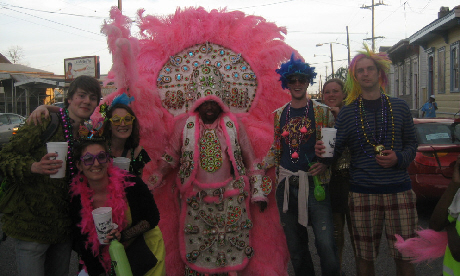
As New Orleans celebrated another Mardi Gras, Thomas Rees reflects on one of the world's great festivals
Passing crowds of party-goers in patchwork waistcoats and hats festooned with coloured feathers we make our way through the drizzle to Bourbon Street. Music spills out of the bars and in one of them a giant of a man with a sousaphone wrapped around him like a silver python hammers out a bassline.
From then on the night is a blur of bright lights as we dance through the French Quarter, calling up at the wrought iron balconies with hoarse voices for strings of iridescent beads to hang around our necks. Beneath our feet, the gutters are thick with discarded plastic.
Every year in the run up to Lent, New Orleans plays host to Mardi Gras, “the biggest free party on earth” which culminates on Mardi Gras Day itself (Shrove Tuesday) after which belts are tightened, or are supposed to be at any rate. Until then it's all about excess: about casting off your inhibitions, embracing beer and beignets and getting your hands on as many parade 'throws' as possible.
Organised by clubs and residents' associations known as krewes, it's the parades that lie at the heart of Mardi Gras. Locals and visitors alike turn out in their thousands to cheer them on, waiting to catch the bead necklaces, spongy footballs (the American kind) and cuddly toys thrown from the floats. There are families gathered around barbecues roasting crayfish and ears of maize, gaggles of old men with coolers of beer, and children raised above the crowds on step ladders painted with Mardi Gras colours (purple for justice, green for faith and gold for power).
At the Zulu parade on Mardi Gras day we watched as floats decorated with palm trees, leopards and tribal warriors trundled under an underpass that echoed with the pounding bass of a gigantic sound system. The hand-painted coconuts thrown from the Zulu floats are one of the great prizes of Mardi Gras. Fighting through a forest of raised arms, I caught three and had the bruises to show for it.
But parades are not just about lumbering fibreglass floats. There are pompom waving high school dance troops, lasso swinging cowboys topped and tailed with Stetsons and spurs and, of course, there are the marching bands. A riot of thundering drums, and raucous jazz-infused melodies, their music is the sound track to the festival. It hits you like a wave and you can’t help but smile.
If Mardi Gras is steeped in music, it's also steeped in history. On our final afternoon in the city we set out in search of the famed Mardi Gras Indians. As a tribute to the tribes of Native Americans who aided runaway slaves from the plantations in the 19th century, members of New Orleans’ population take to the streets on Mardi Gras Day dressed as Indians, staging fights for the entertainment of the crowds. Hand stitched with feathers and thousands of sequins, their costumes are a sight to behold, as lavish as any you'll see at the parades, garish and exquisite in equal measure.
It's that that makes Mardi Gras great. It may be tasteless and excessive but it's unashamedly so. It's always fun and sometimes it's so over the top that it's beautiful.
Want to join next year's party? With accommodation at a premium during the festival, it pays to book in advance.
Flights from the UK to New Orleans involve transfers in the USA, typically in New York, Houston or Chicago with a total journey time of around 20 hours.
Mardi Gras 2015 falls on the 17th of February. Celebrations begin a fortnight beforehand and take place across the city. The biggest celebrations fall on the final weekend of the festival and on Lundi Gras and Mardi Gras Day itself. Full details are available here.
Away from the festival the city has much to offer. Don't miss the opulent mansions of the Garden District and the lacy balconies of the French Quarter, home to may of the city's best music venues including Snug Harbor and Preservation Hall.
For further insight into the culture and traditions of the city and its iconic festivals, head to the Backstreet Cultural Museum in the residential district of Tremé.
Café du Monde is the spot to try beignets, square doughnuts served warm and blanketed in icing sugar. Other classic New Orleans dishes include Gumbo (shellfish stew) and Po' Boys, French bread sandwiches filled with fried oysters, soft shell crab, shrimp or roast beef.